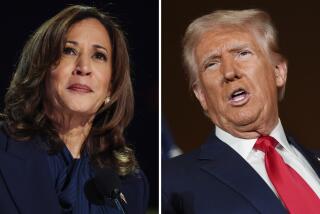Cut Tax Rates and Watch Charitable Giving Slump : Campaign ‘96: The tax benefits of donations would shrink just as the boomers reach their philanthropic prime.
- Share via
Elizabeth Dole recently told an interviewer that if her husband wins the presidency, she will use her role as first lady to “help lead a movement in America to increase charitable giving.” But if Bob Dole is elected, the first thing Mrs. Dole will have to do is persuade her husband to junk the tax plan that he used to win the Oval Office. If she fails to do that, the candidate’s promise to cut taxes across the board by 15% is certain to severely harm some of America’s most cherished charities.
The supply-side economics of the 1980s taught us one thing: Sharp marginal rate tax cuts for the wealthy drastically reduce charitable contributions. The charitable deduction reduces how much it costs us to give by allowing every dollar we contribute to be deducted from our taxable income. Charitable donations reduce taxes by the amount of the donation times the taxpayer’s marginal tax rate. When that marginal rate is cut by 15%, the same charitable donations reduce taxes by 15% less. With less of a tax incentive to give, fewer donations are made. It’s really that simple.
Vice presidential candidate Jack Kemp would claim that with the extra money in our pockets, we can give more. But this is just revisionist economic history. President Reagan and his supply-side soldiers dropped the top marginal tax rate from 70% to 50% in 1981; by 1988 the top rate was only 28%. A widely cited 1992 National Tax Journal study found that these tax cuts caused those who earned more than $1 million a year to give 11% less in 1983, 26.3% less in 1985 and 39.7% less in 1989. The study also concluded that those earning between $200,000 and $1 million contributed 27.5% less to charities in 1989 because of the tax cuts. But we do not need advanced economic analysis to understand the problem. The same study found that actual contributions among those earning more than $1 million a year fell from an average of $133,837 in 1979 to $82,113 by 1989 when income and dollars are adjusted for inflation. Taxpayers with incomes between $200,000 and $1 million a year gave an average of $11,104 in 1979; by 1989, that figure had shrunk to $8,476.
History has shown wealthy donors to be consistent ones; higher education and the arts have been their favorites for decades. This means that charitable gifts to colleges, universities, medical centers, museums and other centers of learning surely would suffer under a Dole tax cut. Furthermore, these institutions are not exactly basking in the overwhelming generosity of their supporters. Today, 25% of wealthy individuals gives less than one-half percent of income to charity. Charity from the wealthy has a split personality: A few give a lot, while the great majority do not.
The stakes during the next presidential term could not be much higher. Fund-raising specialists expect overall giving to increase at the greatest rate in history between 1998 and 2002, just in time for the baby boomers to set into their prime years of charitable giving.
This is one of those defining moments of our national character. As we put the era of Big Government to rest, let us commence the era of Big Charity. A little leadership from President Clinton or the man who wants his job would help. Lest we forget President Bush’s call to be one of a “thousand points of light.”
More to Read
Get the L.A. Times Politics newsletter
Deeply reported insights into legislation, politics and policy from Sacramento, Washington and beyond. In your inbox twice per week.
You may occasionally receive promotional content from the Los Angeles Times.










